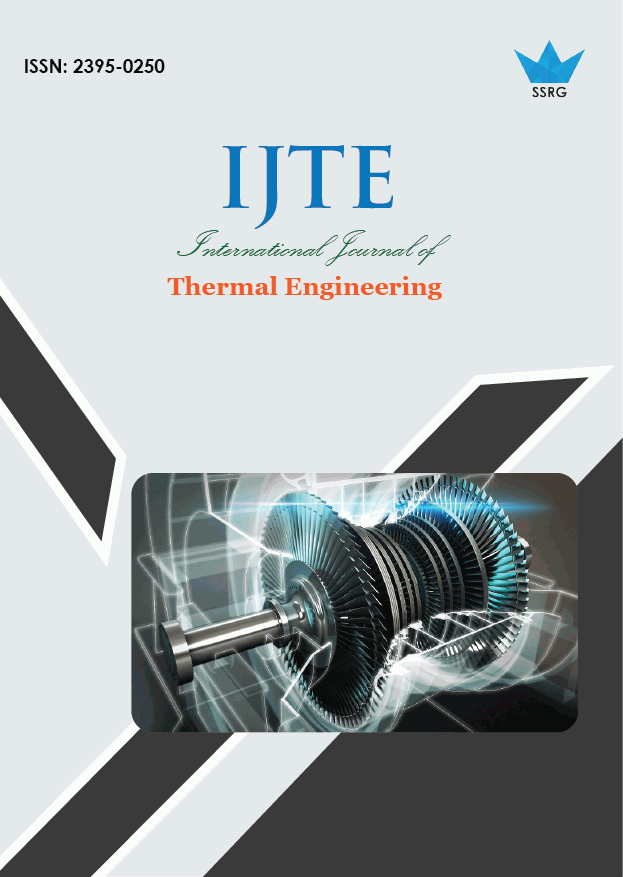A Review on Thermal Performance Analysis for Annular Fins of Various Profiles using Ansys

| International Journal of Thermal Engineering |
| © 2018 by SSRG - IJTE Journal |
| Volume 4 Issue 3 |
| Year of Publication : 2018 |
| Authors : Virendra Bisen, Prof. N.k. Sagar |
How to Cite?
Virendra Bisen, Prof. N.k. Sagar, "A Review on Thermal Performance Analysis for Annular Fins of Various Profiles using Ansys," SSRG International Journal of Thermal Engineering, vol. 4, no. 3, pp. 5-7, 2018. Crossref, https://doi.org/10.14445/23950250/IJTE-V4I3P102
Abstract:
The annular fins acts as best heat sink for liberating heat energy generated during operation of various components used in thermal devices.. Enhancement in heat transfer rate can be achieved by different methods like perforation of different shapes, increasing the surface area as convective heat transfer depends on surface area. Increasing no of perforation & area of perforation to optimum value also has positive effect in achieving increased heat transfer rate. Heat transfer rate enhancement for different profiles of annular fin using perforation has been review in this paper.
Keywords:
Natural convection, forced convection, annular fins; Perforation, Convective Heat transfer coefficient, pressure drop.
References:
[1] M.Sudheer et.al.“ Finite element analysis of thermal characteristics of annular fins with different profiles” ARPN Journal of Engineering and Applied Sciences 2012
[2] Chen. et al. “Analytical analysis and experimental verification of trapezoidal fin for assessment of heat sink performance and material saving” Applied Thermal Engineering 98 (2016) 203–212
[3] M.T. Darvishi et.al. “Numerical investigation for a hyperbolic annular fin with temperature dependent thermal conductivity” Propulsion and Power Research 2016;5(1):55–62
[4] Kiran b. et.al. “Performance and Optimization of Annular Fins by Using Finite Element Analysis” International Journal of Latest Trends in Engineering and Technology (IJLTET) Vol. 3 Issue 4 March 2014
[5] Gaurav A. et.al. “Effect of Percentage of Perforation on the Natural Convection Heat Transfer from a Fin Array” International Journal of Engineering and Technical Research (IJETR) ISSN: 2321-0869, Volume-3, Issue-2, February 2015
[6] Abdullah H.et.al.“ Augmentation of Fin Natural Convection Heat Dissipation by Square Perforations” Journal of Mechanical Engineering and Automation 2012, 2(2): 1-5
[7] Han-Taw Chen et.al. “Estimation of heat transfer coefficient on the fin of annular-finned tube heat exchangers in natural convection for various fin spacings” International Journal of Heat and Mass Transfer 50 (2007) 1750–1761
[8] Isam H. E. Qasem and Abdullah H. M. AlEssa “One Dimensional Finite Element Analysis of Heat Dissipation from Rectangular Fin with Longitudinal Hexagonal Perforations” 2015
[9] Hong-Long Chen et.al. “Analytical analysis and experimental verification of trapezoidal fin for assessment of heat sink performance and material saving” Applied Thermal Engineering 98 (2016) 203–212
[10] Iqbal, Z., Syed, K.S., and Ishaq, M., 2011 Optimal convective heat transfer in double pipe with parabolic fins, International Journal of Heat and Mass Transfer, Pages, 5415–5426
[11] Sudheer, M., Shanbhag, G. V., Kumar, P., and Somayaji, S., 2012. finite element analysis of thermal characteristics of annular fins
[12] Karan sehgal et al. “Method to maximise the heat transfer Through fins.” IJRDO-Journal Of Mechanical And Civil Engineering.
[13] M.Eren, et al. “Effect of grooved pin-fins in a rectangular channel on heat transfer augmentation and friction factor using Taguchi method. International Journal of Heat and Mass Transfer 102 (2016) 1108–1122
[14] H.Singh et al. “ Convective Cooling of Electronic Components.” Experts from proceeding of the COSMOL conference in Boston
[15] V.Karthikeyan et al “Design and Analysis of Natural Convective Heat Transfer Coefficient Comparison between Rectangular Fin Arrays with Perforated and Fin Arrays with Extension.” International Journal of Science, Engineering and Technology Research (IJSETR), Volume 4, Issue 2, February 2015

 10.14445/23950250/IJTE-V4I3P102
10.14445/23950250/IJTE-V4I3P102